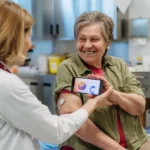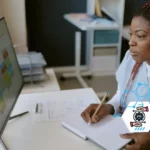Manage Chronic Conditions Using Remote Patient Monitoring (RPM)

Remote patient monitoring (RPM) assists healthcare providers and physicians in monitoring their patients’ health remotely, outside of traditional clinical settings. In other words, it monitors and manages a wide range of illnesses without requiring patients be physically present in a clinical setting.
RPM offers many advantages to healthcare providers, mainly due to its adaptability and potential to enhance patient outcomes while lowering healthcare expenses.
In this blog, we’ll provide a brief overview of the chronic or ill-health conditions that can be effectively monitored through RPM.
Table of Contents
ToggleHealth Conditions Addressed With Remote Patient Monitoring (RPM)
Remote patient monitoring can boost patient engagement, reduce the occurrence of hospital readmission, and lower healthcare costs by delivering more efficient care in a virtual setting. Some of the most common conditions that can be remotely monitored and managed using RPM include:
- Chronic Conditions
Remote patient monitoring is used to manage chronic diseases and allows patients to track their symptoms and vital signs from home, allowing healthcare providers and physicians to monitor them remotely. Some of these chronic conditions include diabetes, high blood pressure, heart failure, chronic obstructive pulmonary disease (COPD), and kidney disease.
By managing chronic conditions, RPM helps improve patient engagement, treatment plans, diagnose health issues, reduce hospital readmissions, and enable better patient and physician communication.
- Post-Surgical Care
RPM is used to monitor patients who have recently undergone surgery and are in post-surgical care. This includes monitoring vitals, infection symptoms, assessing discomfort, and ensuring adequate care. With RPM, clinicians can remotely monitor patients’ recovery progress and make any alterations to the treatment plan, if necessary.
Physicians can monitor their patient’s vital signs, such as blood pressure, heart rate, weight, and oxygen saturation to ensure they remain within normal limits. This consistent monitoring helps identify any potential concerns, such as infection or other exacerbations at an early stage.
- Elderly Care
RPM can help elderly patients monitor their chronic illnesses using remote patient monitoring devices that are quite simple to use and need a little setup. RPM software, cellular devices, and wearables are designed keeping usability for elderly people in mind. Not only this, remote patient monitoring system providers also deliver technical assistance and RPM onboarding to train patients and providers on utilizing the system in the best possible manner.
When it comes to elderly care, RPM is an effective strategy used for managing illnesses, such as rheumatoid arthritis and Alzheimer’s disease, along with improving clinical outcomes, reducing hospitalizations, and boosting patient satisfaction.
- Respiratory Diseases
Remote Patient Monitoring helps patients with respiratory disorders, such as asthma and COPD in monitoring their breathing patterns and oxygen levels. Using FDA-approved remote patient monitoring devices, patients can measure vital signs such as lung capacity and blood oxygen levels in the comfort of their homes and physicians can act on the records to provide the right treatment.
Consistent monitoring of peak flow measurements in asthma patients can aid in detecting early indicators of asthma conditions and allow patients to seek timely medical attention.
Frequently Asked Questions (FAQs)
Remote patient monitoring enables real-time tracking of physiological data (e.g., blood pressure, glucose, oxygen saturation) for patients with chronic conditions. This continuous monitoring allows clinicians to detect worsening trends early, adjust care plans proactively, and reduce adverse outcomes.
Conditions such as diabetes, hypertension, heart failure, chronic obstructive pulmonary disease (COPD), and chronic kidney disease are particularly well-suited for RPM solutions, as they involve ongoing monitoring and risk of deterioration.
Key steps include identifying eligible patients, deploying appropriate connected devices, educating patients and caregivers on usage, establishing data monitoring workflows, setting alert thresholds, integrating RPM data into the electronic health record (EHR), and developing response protocols.
By providing patients with devices and feedback loops, RPM fosters self-monitoring and awareness of their condition. Patients become more engaged when they see their data, receive timely reminders or messages, and share information with their care team. This higher engagement supports better adherence and outcomes.
Institutions using RPM for chronic-condition populations often observe fewer hospital readmissions, fewer emergency-room visits, improved vital-sign stability, and lower resource utilization. These results translate into cost savings, while practices may also open new reimbursement opportunities.
Common devices include connected blood pressure cuffs, glucometers (and continuous glucose monitors), weight scales (for heart failure), pulse oximeters, spirometers (for lung conditions), and medication-adherence sensors. These devices upload data automatically for provider review.
Yes. RPM data and workflows can align with CCM programs: RPM provides real-time physiologic monitoring, while CCM offers structured non-face-to-face care coordination. Together they support holistic chronic-disease management.
Challenges include selecting the right patient cohort, ensuring device adherence, handling large volumes of data, integrating with existing EHRs and workflows, securing connectivity and data transmission, training staff, and maintaining patient engagement over time.
By continuously tracking key vitals, RPM systems can flag deviations or worsening trends (e.g., rising BP, weight gain in heart failure, rising glucose levels). The care team can intervene earlier—through outreach, medication adjustments, or scheduling a visit—thereby averting acute episodes.
Important vendor features include strong device integrations, cellular connectivity (minimizing patient WiFi dependency), seamless EHR integration (HL7/FHIR), alerting and analytics, patient-engagement tools (SMS, apps, coaching), workflows aligned with chronic-care protocols, and reimbursement tracking.
Data from RPM devices is fed into dashboards and EHRs, allowing clinicians to view trends, adjust care plans, set goals, and monitor progress. This integration supports care plan updates, patient coaching, and documentation for billing.
While results vary by population and condition, many practices report improved engagement and monitoring within months and meaningful reductions in readmissions, or ER visits, within 6–12 months. The key is consistent data capture and timely response. (Note: timeline drawn from practice reports; specific results depend on implementation.)
Conclusion
RPM is a versatile remote health technology that allows healthcare professionals and patients to track their health and chronic conditions. It assists patients in better managing their symptoms by providing real-time health status updates.
HealthArc is your top choice digital health platform for remote patient monitoring, chronic care management, transitional care management, principal care management, Remote Therapeutic Monitoring and behavioral health integration. Our HIPAA-compliant software offers billing assistance, device management, and API connectivity dashboards to deliver seamless remote healthcare solutions.
Schedule a demo to learn how our RPM program can help monitor and manage ill-health conditions or call us today at +201 885 5571 to set up a consultation with our experts.
Most Recent Blogs
Categories
Related Blog
- February 21, 2025 | Read Time: 6 mins
RPM’s Role in Identifying Early Symptoms of Chronic Conditions for Prevention
Remote patient monitoring (RPM) systems allow for the continuous tracking of essential...
Learn More- December 5, 2024 | Read Time: 8 mins
How Remote Patient Monitoring Improves Chronic Care Management?
Chronic Care Management (CCM) provides coordinated support for patients with multiple long-term...
Learn More- November 22, 2024 | Read Time: 8 mins
Chronic, Principal, and Transitional Care Management Software: Which Is Right for You?
Want to boost patient engagement and health outcomes at your healthcare practice?...
Learn More


